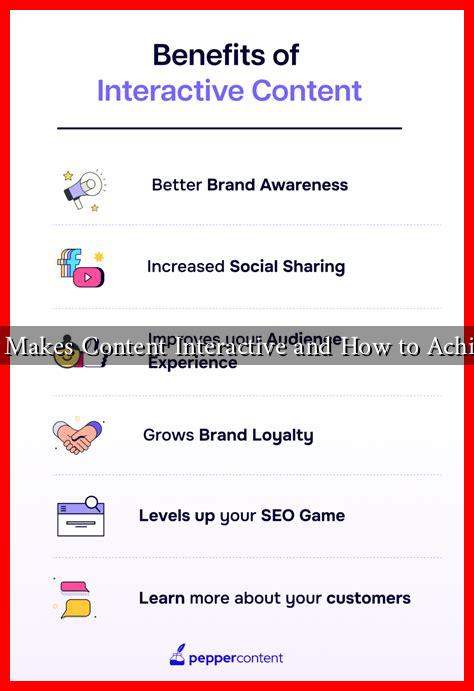-
Table of Contents
What Makes Content Interactive and How to Achieve It
In the digital age, where attention spans are dwindling and competition for engagement is fierce, interactive content has emerged as a powerful tool for marketers, educators, and content creators. But what exactly makes content interactive, and how can you create it? This article delves into the elements that define interactive content and provides actionable strategies to achieve it.
Understanding Interactive Content
Interactive content is any type of content that requires active engagement from the user, rather than passive consumption. This can include quizzes, polls, infographics, videos, and more. The key characteristic of interactive content is that it encourages users to participate, making the experience more engaging and memorable.
Key Elements of Interactive Content
To create effective interactive content, consider the following elements:
- Engagement: The content should invite users to take action, whether it’s clicking, swiping, or answering questions.
- Personalization: Tailoring content to individual preferences enhances user experience and increases relevance.
- Feedback: Providing immediate feedback, such as results from a quiz, keeps users engaged and encourages them to continue interacting.
- Visual Appeal: High-quality visuals and design elements can attract users and enhance the overall experience.
- Storytelling: Incorporating narratives can make the content more relatable and engaging.
Types of Interactive Content
There are various forms of interactive content that can be utilized across different platforms. Here are some popular types:
- Quizzes and Polls: These are excellent for engaging users and gathering insights. For example, BuzzFeed’s quizzes have become a cultural phenomenon, driving significant traffic to their site.
- Interactive Infographics: These allow users to explore data in a more engaging way. For instance, the New York Times often uses interactive infographics to present complex information.
- Videos with Interactive Elements: Platforms like YouTube allow creators to add clickable elements to videos, enhancing viewer engagement.
- Calculators and Tools: These can provide personalized results based on user input, such as mortgage calculators or fitness assessments.
How to Create Interactive Content
Creating interactive content involves a strategic approach. Here are some steps to guide you:
- Define Your Goals: Understand what you want to achieve with your interactive content. Is it to educate, entertain, or generate leads?
- Know Your Audience: Tailor your content to the preferences and interests of your target audience. Conduct surveys or analyze user data to gain insights.
- Choose the Right Format: Select a format that aligns with your goals and audience preferences. For example, if your audience enjoys quizzes, consider creating a fun quiz related to your topic.
- Utilize Technology: Leverage tools and platforms that facilitate the creation of interactive content. Tools like Typeform for surveys or Canva for infographics can be incredibly useful.
- Test and Iterate: After launching your interactive content, gather feedback and analyze performance metrics. Use this data to refine and improve future content.
Case Studies and Statistics
Interactive content has proven to be effective in various industries. According to a study by Content Marketing Institute, interactive content generates twice as many conversions as passive content. Additionally, companies that use interactive content see a 70% increase in engagement compared to those that do not.
For instance, a case study by HubSpot revealed that a simple quiz increased their lead generation by 50%. This demonstrates the potential of interactive content to not only engage users but also drive business results.
Conclusion
In conclusion, interactive content is a vital component of modern digital strategies. By understanding what makes content interactive and implementing the right techniques, you can create engaging experiences that resonate with your audience. Remember to focus on engagement, personalization, and feedback while utilizing various formats to keep your content fresh and appealing. As the digital landscape continues to evolve, embracing interactive content will be essential for staying relevant and competitive.

